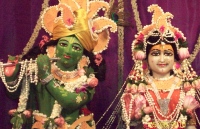Keeping Krishna Cool
By Radha Vallav Das | Jun 12, 2010

On the day of Aksaya Tritiya in Vrindavan, all large temple deities are covered with chandan (sandalwood) paste, and not a bit of cloth is used to cover the deities in the afternoon. The cooling effect of this substance provides relief from the scorching heat of summer. This practice is also followed increasingly by ISKCON temples all over the world, but it has been observed since time immemorial.
Long ago, Lord Jagannatha instructed the ancient King Indradyumna to perform this festival. Since then, every year the large deities are covered with the paste, and the small festival deities are placed in a boat in the temple pond. To commemorate this festival, Sri Chaitanya also performed water sports with his devotees.
Chandan yatra is also said to have been celebrated first on the day when Treta-Yuga began, several million years ago. Ganga Devi, India’s most well-known sacred river, is said to have descended to earth on this day as well.
In the following age, Dvapara Yuga, there is another record of the event. In the Mahabharata, the Pandavas lived in disguise in the palace of King Virata during their year of exile. But after Bhima killed Kichaka, King Virata realized that the Pandavas were living in his palace. The king felt proud and made strong bonds of friendship with them.
Once, the king expressed his desire to see Lord Krishna with the Pandavas. Yudhisthira then advised the king to organize a boat journey in a lake for the amusement of Lord Krishna during the hot summer months. The king did so, and also took the opportunity to embalm the body of the Lord with sandalwood paste in fragrant water.
In more recent times, Madhavendra Puri, the grand spiritual master of Sri Chaitanya, followed suit. When he was in Govardhana, he dreamt of a deity of Gopala buried in the jungles. The Lord said, “Madhava, I am suffocating underground. Please excavate my place and install Me in a temple.” So Madhavendra Puri, with the help of the Annore villagers, excavated the earth and found the deity, and Gopala was soon installed on top of the Govardhana Hill.
One day, Gopala said, “I was beneath the earth for long and My body is worn out. Would you please bring some sandalwood from Jagannatha Puri and smear it on Me to soothe My body?” Madhavendra Puri was then an old man, but he couldn’t deny the order of Lord Gopala. So he set out for Jagannatha Puri.
On the way, he reached Remuna, at the border of Orissa and Bengal, where the Gopinatha temple is located. He stayed there overnight and saw that the priest offered twelve pots of condensed milk to the deity. So Madhavendra Puri thought, “If I could taste a bit of that dish, then I could also make similar offerings to my Gopala in Vrindavan. Immediately, his consciousness scolded him, “Oh, I am so stupid. Before offering it to the Deity, I thought of eating it.” Realizing his mistake, he immediately left the temple. He went outside and sat beneath a tree and chanted the Hare Krisha Mahamantra to pass the night.
During the night, the Deity appeared in a dream to the priest and said, “I have shielded one pot of condensed milk behind My garment. Take it to Madhavendra Puri sitting beneath the tree outside the temple.”
The priest reached the temple and did as instructed. Then the priest described the whole episode to Madhavendra Puri. Thereafter, Gopinatha became famous as Ksira-cora, the one who stole milk for His great devotee.
The next day, Madhavendra Puri set out for Jagannatha to collect chandan for Gopala. Before he reached Puri, the news of his being favored by Gopinatha had spread. When Madhavendra met the priest of Lord Jagannatha and expressed his desire, the priest took him to the King of Puri. Hearing the episode, the king gave Madhavaendra one mana (nearly 37 kg) of special sandalwood, two security guards and a written order to allow Madhavendra free passage.
When he was passing Remuna on the way back to Vrindavana, Gopala appeared in a dream and said, “Madhava, you should embalm Lord Gopinatha with sandal paste, and I too will receive it, for Gopinatha and I are one.” Madhavendra Puri duly anointed Lord Gopinatha with the chandan paste.
Since that time, the Chandan Yatra has been regularly observed in Vrindavana, and now it is celebrated all over the world. It is often accompanied by some kind of boat festival, and devotees also perform special ceremonies and rituals on the occasion, such as bathing in a holy river, offering charity, conducting fire sacrifices using barley and making preparations of delicious food using barley. The largest component, however, is always the actual hand grinding of the sandalwood paste (approximately 100 kilograms are used in Vrindavana), a task which involves dozens of devotees over the month preceding the event.












